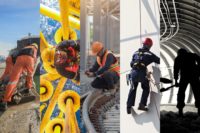Industrial facilities are inherently dangerous places. In fact, according to the National Safety Council, workplace injuries account for nearly $190 billion in losses annually. Despite the efforts of regulatory bodies and safety-minded employers, these dangers may even be increasing due to heightened economic pressures and trends like increased automation and robotics. In many cases, the need for organizational belt-tightening has led companies to maximize space within their facilities, expanding upwards (instead of outwards) with elevated work platforms or multi-level racking systems to create additional storage space or work areas. These multi-level work environments allow companies to add floor space without adding to their facility’s footprint – which is generally less costly and time-consuming than expanding outward, leasing new space or constructing a new facility.
While multi-level environments create a number of advantages and efficiencies for companies, they do create safety challenges that must be addressed. Most significantly, unprotected mezzanine or multi-level environments pose a high risk for fall-related injuries to employees. According to OSHA, falls are among the most common cause of serious work-related injuries and deaths. Fatal falls, slips or trips took the lives of 699 workers in 2013. Falls to a lower level accounted for 574 (82 percent) of those fatalities – with roughly 1/5 coming from falls of over 30 feet.
OSHA regulations vs. ANSI standards
A division of the U.S. Department of Labor, OSHA is charged with developing and enforcing safety standards within the work environment. OSHA regulations are law and must be followed by employers and their work force. However, since OSHA is charged with regulating a wide variety of industries, it is difficult for the administration to stay on top of rapidly-evolving changes within specific industries. As a result, many companies look to organizations like the American National Standards Institute (ANSI) for “best practices” guidelines. ANSI promotes voluntary consensus standards that are widely recognized as comprehensive and reliable when it comes to workplace safety. ANSI standards are up-to-date and provide specific direction on how to maximize workplace safety. Compliance with ANSI standards ensures that companies are implementing the most advanced safety standards in their respective industries.
In 2009, ANSI issued a standard entitled: Specification for the Design, Manufacture and Installation of Industrial Work Platforms (MH28.3: 2009). According to this standard an industrial work platform is a prefabricated elevated platform (e.g., mezzanine) located in an industrial environment, pre-designed using a steel framing system. Flooring may include other structural or non-structural elements such as, but not limited to, concrete, steel, and/or engineered wood products. This new specification is intended to be applied to the design, manufacturing, installation, and maintenance of such structures.
Mezzanine safety solutions
Based on current standards, industrial mezzanines must have handrails and gates around all edges; however, these gates need to be opened from time-to-time to accommodate the loading and unloading process. According to the ANSI standard, companies must provide full-time protection when loading and unloading materials from an elevated platform – there can be no exposed areas where an employee could potentially fall. As a result, many companies are seeking a solution to secure elevated work environments.
Dual reciprocating barriers are becoming increasingly popular for this application, since they create a controlled access area in which the inner gate and outer gate cannot be opened at the same time. Leading models use a link bar design that ensures both gates work in unison; when the outer gate opens to allow pallets in, the inner gate automatically closes to keep workers out. After the pallet is received, mezzanine-level workers open the inner gate to remove material from the work zone while the outer gate closes to secure the leading edge of the platform.
Pick module safety
In addition to mezzanines and elevated work platforms, many companies are integrating multi-level pick modules within their facilities to handle order fulfillment. Pick modules are typically constructed using a metal support structure, flooring, stairways, handrails, and landings. Products are stored in shelving and racks and are “picked” to conveyors, totes, carts, and other transportation systems.
Multi-level rack systems pose a number of challenges when it comes to securing open areas during the loading and unloading process. The work areas are typically very small and are contained within the rack system itself, which makes it difficult to integrate traditional safety barrier designs.
The bottom line
Elevated work areas such as pick modules and mezzanines are increasingly common in industrial facilities across the United States. Since they can be a highly cost-efficient way for facilities to add floor space without expanding the physical footprint of their plant, most industry experts expect this trend to continue. However, facility managers contemplating the addition of elevated workspaces must take OSHA-mandated safety regulations – and should take ANSI best practices guidelines – into consideration when designing and outfitting these areas. In both cases, dual reciprocating barriers can be a key element in safeguarding employees and ensuring regulatory compliance.


